Wednesday, August 15, 2012
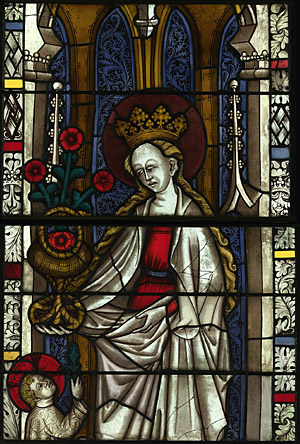
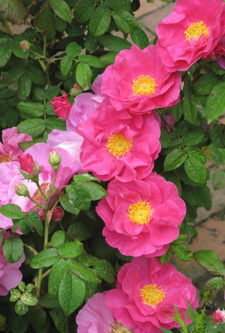
Left:?? Roses are one of the special attributes of Saint Dorothea, as shown in the detail of this stained-glass panel; Right: Rosa gallica officinalis blooming in Bonnefont garden. Remarkably, the rose has retained its ancient name in dozens of modern languages.
The rose has been known by the same name throughout Europe since antiquity. It began as vrda in ancient Persia (related to the modern Arabic warda) and became known as rhodon to the nearby ancient Greeks. (Oddly, the modern Greek for rose is triantafillo, meaning “thirty leaves,” while rhodon remains in our “rhododendron,” meaning “rose tree”). By the time of the Roman Empire the name had become rosa, immediately recognizable in most modern European languages???rosa (Italian and Spanish), roos (Dutch), ros (Swedish), rosier (French)???and many others, including the Japanese rozu.
Read more »
Tags: carline thistle, Dioscorides, etymology, herb robert, Hildegard of Bingen, Linnaeus, Physica, rose, Theophrastus
Posted by maggiefitzpatrick on Wednesday, August 15 at 10:15 am | Comments (2)
Friday, August 10, 2012
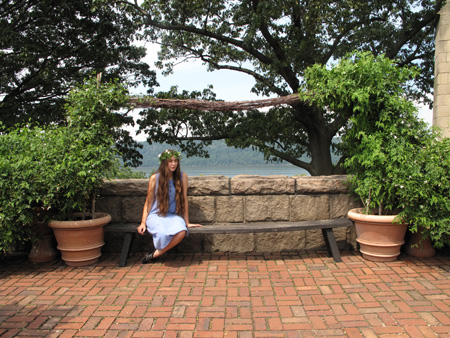
Arbors covered with vining or climbing plants, also called bowers, were a common feature of medieval pleasure gardens, and women are often shown seated in their shade. Maggie Fitzpatrick, summer intern in the gardens, rests from her labors under a fragrant jasmine bower in Bonnefont garden. The jasmine, grown in terra cotta pots, twines up and around a structure of birch poles and birch brush, lashed together with copper wire and finished with barked wire.?? Photograph by Carly Still
Arbour, arbor, n. A bower or shady retreat, of which the sides and roof are formed by trees and shrubs closely planted or intertwined, or of lattice-work covered with climbing shrubs and plants, as ivy, vine, etc. Forms: ME???15 erber (e, herber(e, ME herbier, erbor, arbre, ME???15 arber, 15 herbor, harber, herbour, arboure (all obs.), 15??? arbour, arbor. (The original characteristic of the ???arbour??? seems to have been the floor and ???benches??? of herbage; in the modern idea (since 16th c. at least) the leafy covering is the prominent feature.)
???OED Online. June 2012. Oxford University Press: http://0-oed.com.library.metmuseum.org/view/Entry/10234 (accessed August 9, 2012).
Arbors covered with vines or roses are frequently depicted in medieval garden representations, often in conjunction with a turf bench or garden seat. Elegant ladies are shown taking their ease, or the Virgin and Child are shown seated in state, as in Stefan Lochner’s famous Madonna of the Rose Bower in Cologne. (For more on turf benches, see “A Green Place to Rest,” March 15, 2010.) Read more »
Tags: arbor, bower, jasmine
Posted by Deirdre Larkin on Friday, August 10 at 9:42 am | Comments (0)
Friday, August 3, 2012
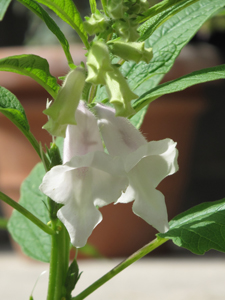
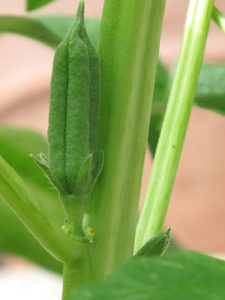
Sesame, also known as “benne,” is a tender, large-leaved, Asian annual grown here in Bonnefont garden. Sesame has been cultivated for some five thousand years and was known to many cultures in antiquity. Although the plant is somewhat rangy and coarse in habit, the tubular flower (above, left) is attractive. The immature green pods (above, right), which will split and spill out their seeds when ripe, contain one of the world’s oldest domesticated oilseeds. The seeds also have a long history of use as a seasoning.??Photographs by Carly Still.
A cultivated plant of fabulous antiquity, sesame (Sesamum indicum) is known as simsim in Arabic, susam in Turkish, sesam in German, s??same in French, sesamo in Italian, and sesame in Spanish. Called sesemt by the ancient Egyptians, it was also grown in Ethiopia in very early times. Sesame seeds were taken from West Africa to America by slave traders; the name “benne” derives from the West African benni. Sesame had long been grown in India and Persia, and was introduced to China by the end of the fifth century A.D. Read more »
Tags: De Materia Medica, Dioscorides, flax, hellebore, Herodotus, Hortus Sanitatis, John Ruskin, poppy, sesame, Sesamum indicum
Posted by Deirdre Larkin on Friday, August 3 at 11:01 am | Comments (0)
Friday, July 27, 2012
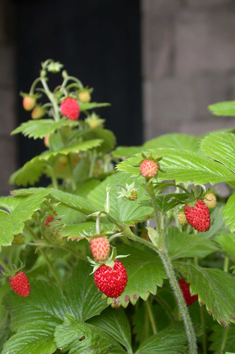
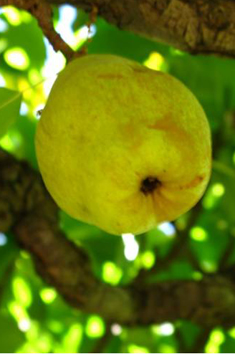
Both edible and medicinal plants were classified by their qualities in the Middle Ages. A given plant might be heating, cooling, moistening, or drying in its action on human bodies; the intensity of this action was expressed in degrees. An herb or foodstuff that was a little cooling was “cold in the first degree,” while a very cooling plant was classed as “cold in the fourth degree.” Above, left: Strawberry (Fragaria vesca) was a mildly cooling fruit, being cold and moist in the first degree. Pear (Pyrus communis) was more refreshing, being cold in the second degree and moist in the first.
The medicinal model inherited by the Middle Ages, based largely on humoral theory, was essentially a “cure by contraries” rooted in the idea that illness was the result of an imbalance of the humors???blood, choler, bile, and phlegm???within an individual. Plants and other substances were either warming, cooling, moistening, or drying in their action on human bodies, which were sanguine, phlegmatic, melancholic, or choleric in complexion. Read more »
Tags: Fragaria vesca, Galen, Hippocrates, humors, Mentha x piperita, mint, pear, peppermint, Portulaca oleracea, purslane, Pyrus communis, Rumex acetosa, sorrel, strawberry, Tacuinum Sanitatis, Tillyard, William Turner
Posted by Deirdre Larkin on Friday, July 27 at 12:01 pm | Comments (1)
Monday, July 16, 2012
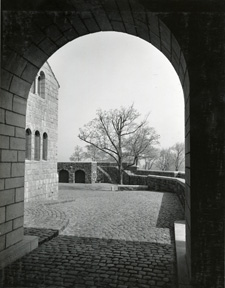
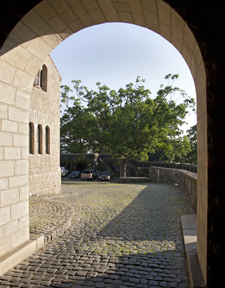
The courtyard, as seen from the portcullis gate entrance in 1938, at left, and in 2012, at right. Photograph on right by Andrew Winslow
Visitors to The Cloisters may have spied the top of a large oak tree just above the wall at the postern gate entrance. This white oak grows in a courtyard enclosed by the ramparts, which also include maintenance passages, storage, an education workshop area, and garden workspaces.
Read more »
Tags: acorn, oak, Quercus, tree
Posted by Christina Alphonso on Monday, July 16 at 2:00 pm | Comments (3)
Friday, June 15, 2012
The Cloisters offered its annual Garden Days program on June 2 and 3. We had splendid weather and a great turnout. Deirdre Larkin, familiar to all of our regular readers, led garden tours in which she explored the theme of wild and cultivated plants in the Middle Ages. Instructors from our Education Office led workshops for children and their families.
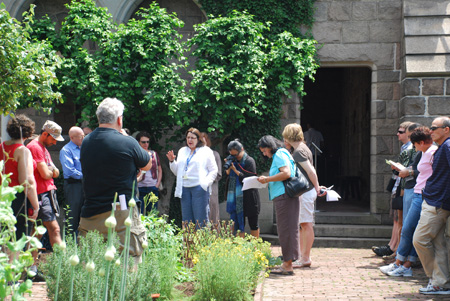
Deirdre Larkin, at center, discussed wild and cultivated plants in the Bonnefont herb garden. Some of the plants in the garden are considered weeds today but were highly valued in the medieval world. Most of the beds in Bonnefont are planted according to use; nearly every bed was completely replanted this spring. Photograph by Nancy Wu
Read more »
Tags: Bonnefont Garden, Cuxa Garden, Garden Day, weed
Posted by Christina Alphonso on Friday, June 15 at 8:00 am | Comments (2)
Friday, May 25, 2012
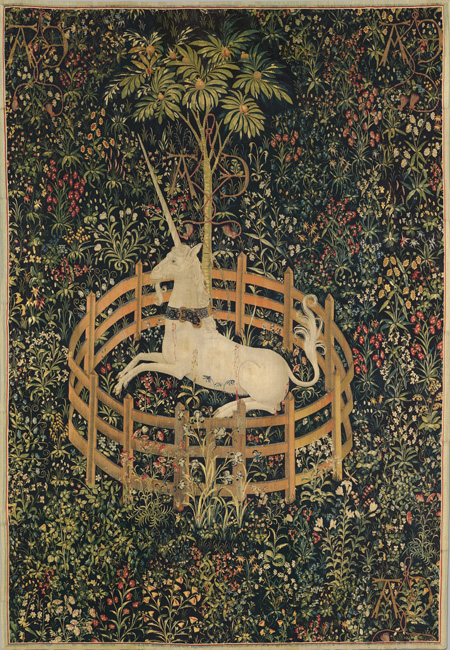
The Unicorn in Captivity, 1495???1505. The Metropolitan Museum of Art, New York, Gift of John D. Rockefeller Jr., 1937 (37.80.6). The profusion of flowering plants that springs from the millefleurs meadow on which the unicorn rests includes both garden plants and wildflowers. An iris and a clove pink are prominently placed outside the unicorn’s enclosure; both were intensively cultivated in the Middle Ages, but the purple orchis silhouetted against the unicorn’s body depends on a special relationship with microorganisms in its native soil and would not have grown in gardens.
Roses, lilies, iris, violet, fennel, sage, rosemary, and many other aromatic herbs and flowers were prized for their beauty and fragrance, as well as their culinary and medicinal value, and were as much at home in the medieval pleasure garden as in the kitchen or physic garden. These plants were carefully cultivated, but many useful plants of the Middle Ages were found outside the garden walls, or admitted on sufferance.
Read more »
Tags: colewort, Fennel, gourd, herb, Hortulus, iris, kale, lamb's quarters, lettuce, lily, melon, nettle, poppy, pulse, purslane, rose, rosemary, sage, violet, Walahfrid Strabo
Posted by Deirdre Larkin on Friday, May 25 at 12:44 pm | Comments (1)
Thursday, April 19, 2012
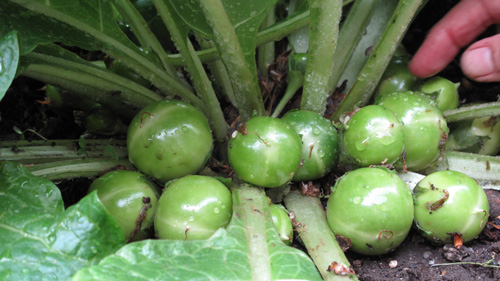
The mandrake above, which flowered in March, now bears a bumper crop of no less than twenty fruits, the largest number we’ve ever seen on a single plant here in Bonnefont garden. The fruits do not always ripen fully for us.?? Photograph by Carly Still
The mandrakes give a smell, and at our gates are all manner of pleasant fruits, new and old, which I have laid up for thee, O my beloved.
???Song of Solomon, 7:13
Read more »
Tags: Mandragora, Mandragora officinarum, mandrake, nightshade, Tacuinum Sanitatis, tomato
Posted by Deirdre Larkin on Thursday, April 19 at 1:38 pm | Comments (2)
Thursday, April 5, 2012
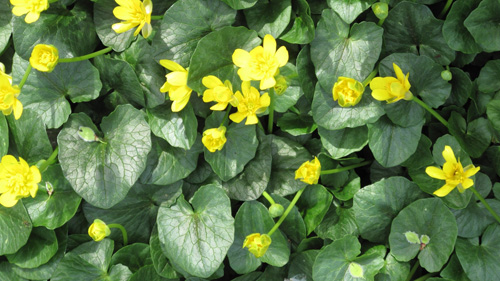
A colony of lesser celandine (Ranunculus ficaria) growing in the orchard below the south wall of Bonnefont garden.
The shining yellow flowers of lesser celandine star the grounds below Bonnefont garden in March and April, but the blossoms and the heart-shaped leaves of this spring ephemeral will disappear altogether by summer. The tuberous roots, which lie just beneath the surface of the soil, will remain dormant until the following spring. This invasive medieval species is not grown within the walls of The Cloisters, but has long been at home throughout the northeastern United States. (See the Ranunculus ficaria page of the Invasive Plant Atlas of New England website.)
Read more »
Tags: buttercup, celandine, Chelidonium majus, Hildegard of Bingen, Hortus Sanitatis, John Gerard, lesser celandine, poppy, Ranunculus ficaria, scrofula
Posted by Deirdre Larkin on Thursday, April 5 at 3:58 pm | Comments (3)
Friday, March 23, 2012
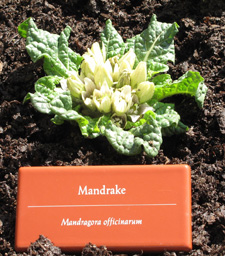
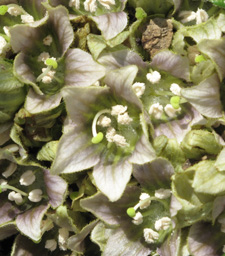
The mandrake, credited with both medicinal and magical powers over the course of many centuries, has accumulated more lore than any other plant in the Western tradition. Above: One of a colony of five spring-blooming mandrakes in Bonnefont garden. In March, this famous member of the nightshade family produces tight clusters of short-stemmed bell-shaped flowers.
Mandrake (mandragora) is hot and a little bit watery. It grew from the same earth which formed Adam, and resembles the human a bit. Because of its similarity to the human, the influence of the devil appears in it and stays with it, more than with other plants. Thus a person’s good or bad desires are accomplished by means of it, just as happened formerly with idols he made. When mandrake is dug from the earth, it should be placed in a spring immediately, for a day and a night, so that every evil and contrary humor is expelled from it, and it has no more power for magic or phantasms.
???Hildegard of Bingen, Physica (translated by Patricia Throop)
Read more »
Tags: alkaloid, Bartholomaeus Anglicus, Dioscorides, Hildegard of Bingen, John Gerard, Mandragora, Mandragora autumnalis, Mandragora officinarum, mandrake, nightshade, Pliny
Posted by Deirdre Larkin on Friday, March 23 at 4:21 pm | Comments (10)















